B-sharp major imperfect authentic cadence
The Solution below shows the 3 most common B-sharp major imperfect authentic cadences on the piano and treble clef.
The Lesson steps then describe the cadence structure in this key, the chords used, followed by an example of its use.
For a quick summary of this topic, have a look at Cadence.
| Key | C | C# | Db | D | D# | Eb | E | E# | Fb | F | F# | Gb | G | G# | Ab | A | A# | Bb | B | [B#] | Cb |
|---|
Solution - 3 parts
1. B-sharp major root position IAC
The root position imperfect authentic cadence moves from the dominant (V), to the tonic (I) scale degree, with both chords in root position.
In contrast to the B# major perfect authentic cadence the tonic of chord I does not need to be the highest note of this chord, and so the cadence is weaker.
So in this major key, we are going from the B# major triad chord #V - F## major chord, to B# major triad chord #I - B# major chord.
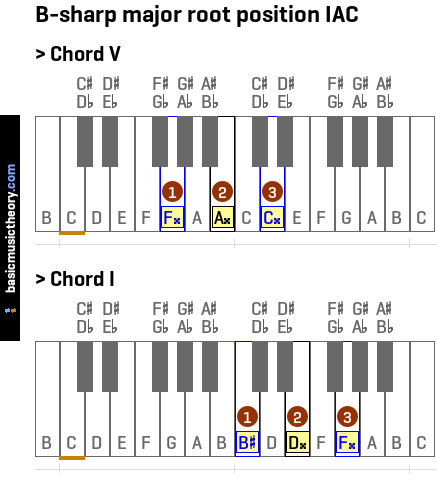
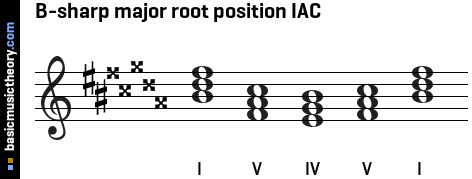
To demonstrate this, on the treble clef above, B# major triad chord #I, B# major triad chord #V, and B# major triad chord #IV are used to set up the phrase as being in this key, then the cadence chords V and I finish off the phrase, giving only a partial sense of completion, in comparison to the perfect authentic variation.
 Treble Clef
Treble Clef
2. B-sharp major inverted IAC
The inverted imperfect authentic cadence moves from the dominant (V), to the tonic (I) scale degree, with one or both chords inverted.
For example, in this major key, we are going from the 1st inversion of B# major triad chord #V - F## major chord, to B# major triad chord #I - B# major chord.
In contrast to the B# major perfect authentic cadence, which has chord V in root position, in this example, this cadence has chord V inverted, but is the same in all other respects.
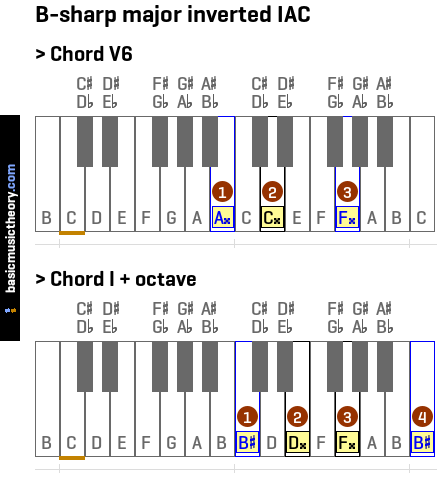

To demonstrate this, on the treble clef above, B# major triad chord #I, B# major triad chord #V, and B# major triad chord #IV are used to set up the phrase as being in this key, then the cadence chords V6 (Chord V in 1st inversion) and chord I finish off the phrase, giving a weaker sense of completion and resolution compared to the perfect authentic cadence.
 Treble Clef
Treble Clef
3. B-sharp major leading tone IAC
The leading tone imperfect authentic cadence moves from the leading note /tone (viio), to the tonic (I) scale degree.
So in this major key, we are going from the B# major triad chord #viio - A## diminished chord, to B# major triad chord #I - B# major chord.
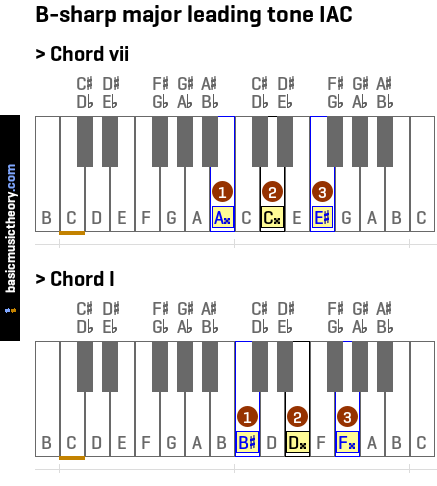

To demonstrate this, on the treble clef above, chords B# major triad chord #I, B# major triad chord #V, and B# major triad chord #IV are used to set up the phrase as being in this key, then the cadence chords viio and I finish off the phrase.
 Treble Clef
Treble Clef
Lesson steps
1. Cadence Types
Cadence definition
In music theory, a cadence is two chords which create a sense of closure, or rest to a phrase, section, or entire piece of music.
The most commonly used are: perfect authentic, imperfect authentic, plagal, deceptive and half cadence.
Some of the above are US-english terms. In the UK, authentic cadences are called perfect cadences, half cadences are called imperfect cadences, and deceptive cadences are called interrupted cadences.
Cadences - strong versus weak
Each of the above cadence types use different chords (or inversions) to create these rest / closure effects.
Strong cadences give a real sense of finality, and so are most often used right at the end of a piece.
In contrast, weak cadences are less conclusive, which can be used to create a sense of rest, or even surprise the listener with a false ending, when a strong cadence was expected in its place.
2. B-sharp major scale notes and chords
Before describing the details of the imperfect authentic cadence in the key of B-sharp major, first it would be to useful to identify the scale notes, degrees and chords that could be used in this key.
B-sharp major scale notes
Below is a piano diagram showing the B# major scale notes.
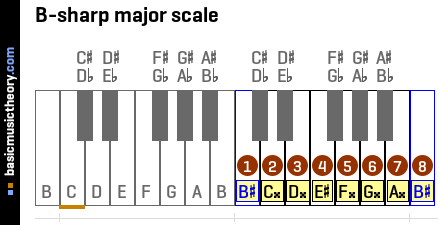
B-sharp major scale chords
For details on all the chords in this scale, have a look at B# major triad chords, and B# major 7th chords, but a summary table of all chord names and their scale degrees is shown below.
| Note no. | Note name | Scale degree | Triad chord # | 7th chord # |
|---|---|---|---|---|
| 1 | B# | tonic | B# major triad chord #I | B# major seventh chord #I7 |
| 2 | C## | supertonic | B# major triad chord #ii | B# major seventh chord #ii7 |
| 3 | D## | mediant | B# major triad chord #iii | B# major seventh chord #iii7 |
| 4 | E# | subdominant | B# major triad chord #IV | B# major seventh chord #IV7 |
| 5 | F## | dominant | B# major triad chord #V | B# major seventh chord #V7 |
| 6 | G## | submediant | B# major triad chord #vi | B# major seventh chord #vi7 |
| 7 | A## | leading tone | B# major triad chord #viio | B# major seventh chord #viiø7 |
For each note in the scale (2nd column), there is a triad chord whose root / first note is that scale note (4th column), and the same applies to 7th chords (5th column).
To understand what the roman numerals mean, please look at B# major triad chords or B# major 7th chords.
According to the cadence type, some of these chords, scale degrees and roman numerals will be used in later steps to define this cadence.
 Bass Clef
Bass Clef
 Treble Clef
Treble Clef
3. B-sharp major root position IAC
Structure
The root position imperfect authentic cadence moves from the dominant (V), to the tonic (I) scale degree.
So looking up the chords relating to these scale degrees from the table above, we are going from the B# major triad chord #V - F## major chord, to B# major triad chord #I - B# major chord.
For an imperfect authentic cadence to be considered in root position, both cadence chords need to be in root position, so on that count the links above are fine - both chords are in root position.
However, in contrast to perfect authentic cadences, which need to have the tonic as the highest note of the tonic chord (I), imperfect authentic cadences do not need have this restriction.
For an example in this key, whereas the perfect authentic cadence added the tonic of the octave note B# onto chord I, creating a chord with 4 notes, the imperfect variation will just use the tonic triad chord as it is, unchanged, with the usual 3 notes.
In this case, the highest note is F##, which is not the triad root, so the cadence is considered imperfect. It is less strong than the perfect version, because it doesn't give the same sense of closure or completion to the phrase.

Example
The two chords above are shown as the last two chords on the treble clef below.
The first three chords on the staff below are not strictly part of the cadence, but they are useful to set the expectation that this phrase is definitely in the key of B-sharp major.
To do this, we are using chords B# major triad chord #I, B# major triad chord #V, and B# major triad chord #IV, and after hearing these chords, followed by the first chord in the cadence (V again), our ear is definitely expecting the tonic chord as the final chord in the sequence.
Since the tonic of chord I is not the highest note in the final chord, the sense of resolution and finality is not there, in comparison to the perfect variation.

The audio files below also contain all 5 chords shown on the treble clef above.
 Treble Clef
Treble Clef
4. B-sharp major inverted IAC
Structure
The inverted imperfect authentic cadence moves from the dominant (V), to the tonic (I) scale degree.
So looking up the chords relating to these scale degrees from the table above, we are going from the B# major triad chord #V - F## major chord, to B# major triad chord #I - B# major chord.
For an authentic cadence to be considered inverted, one or both of these chords can be inverted, so the root of the chord is not the bass note of the chord.
We will use the B# major perfect authentic cadence in the same key as a starting point, then invert the first chord (chord V) of the cadence, and leave the final chord (I + 8th / octave note) unchanged.
To invert chord V, we will move its root - note F##, up one octave, so it has moved from the lowest to the highest note pitch of the chord. By moving the root up, we have created chord V in 1st inversion. Note A## is now the bass note of the chord.

Example
The two chords above are shown as the last two chords on the treble clef below.
The first three chords on the staff below are not strictly part of the cadence, but they are useful to set the expectation that this phrase is definitely in the key of B-sharp major.
To do this, we are using chords B# major triad chord #I, B# major triad chord #V, and B# major triad chord #IV, and after hearing these chords, our ear might expect to hear chord V again, followed by the tonic chord. Instead, we get chord V in 1st inversion followed by the tonic chord.
The inversion of chord V (V6) gives an unexpected twist on the way back to the tonic chord (in comparison to the B# major perfect authentic cadence), so the the cadence feels less predictable and strong as a result.

The audio files below also contain all 5 chords shown on the treble clef above.
 Treble Clef
Treble Clef
5. B-sharp major leading tone IAC
Structure
The leading tone imperfect authentic cadence moves from the leading note / tone (viio), to the tonic (I) scale degree.
In comparison to the B# major perfect authentic cadence, and the imperfect cadences shown above, which all move from chord B# major triad chord #V, this leading tone cadence substitutes chord V for B# major triad chord #viio.
This chord contains the leading tone / note - of the B# major scale - note A## as the chord root.
So looking up the chords relating to these scale degrees from the table above, we are going from the B# major triad chord #viio - A## diminished chord, to B# major triad chord #I - B# major chord.

Example
The two chords above are shown as the last two chords on the treble clef below.
The first three chords on the staff below are not strictly part of the cadence, but they are useful to set the expectation that this phrase is definitely in the key of B-sharp major.
To do this, we are using chords B# major triad chord #I, B# major triad chord #V, and B# major triad chord #IV, and after hearing these chords, our ear is might be expecting chord V then chord I as the final chord in the sequence (as per the B# major perfect authentic cadence).
Although this cadence does give quite a strong resolution and sense of completion, , it is a weaker cadence than the B# major perfect authentic cadence, since the relationship between dominant(V) and tonic(I) is the strongest possible tonal relationship in diatonic scales.

The audio files below also contain all 5 chords shown on the treble clef above.
 Treble Clef
Treble Clef
Related Keys and Topics
| Key | C | C# | Db | D | D# | Eb | E | E# | Fb | F | F# | Gb | G | G# | Ab | A | A# | Bb | B | [B#] | Cb |
|---|